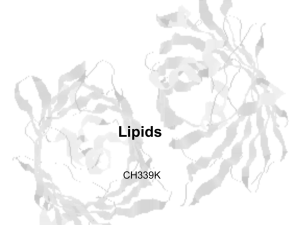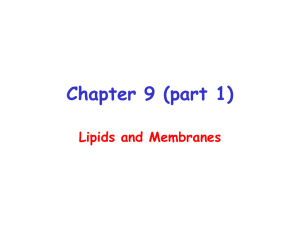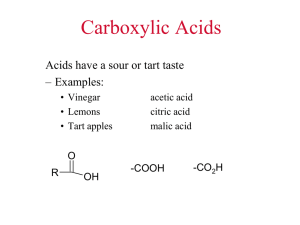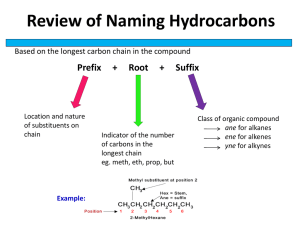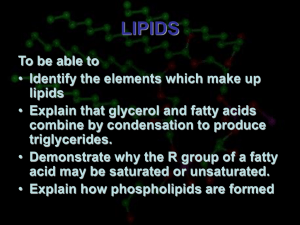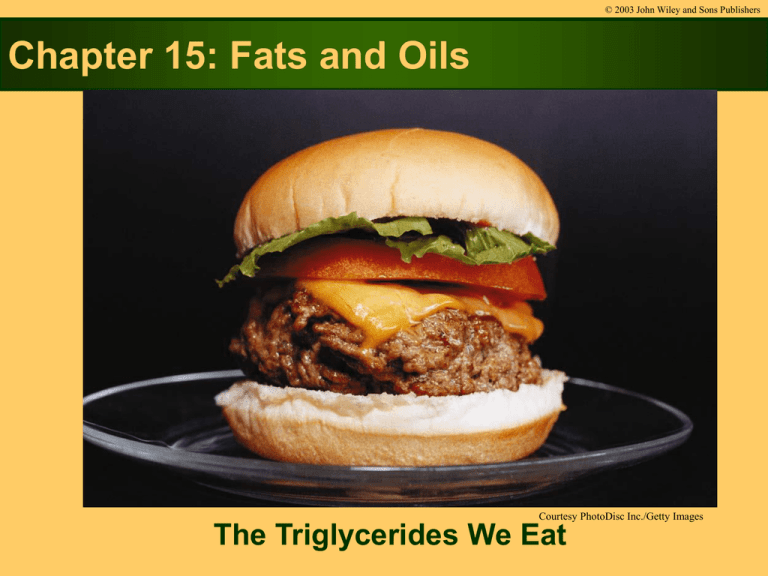
© 2003 John Wiley and Sons Publishers
Chapter 15: Fats and Oils
Courtesy PhotoDisc Inc./Getty Images
The Triglycerides We Eat
© 2003 John Wiley and Sons Publishers
Courtesy Ken Karp
Figure 15.1: The effect of polyunsaturation.
© 2003 John Wiley and Sons Publishers
Courtesy Ken Karp
Fats (solid triglycerides) and an oil (a liquid triglyceride).
Chapter 18 Lipids
18.1 Lipids
18.2 Fatty Acids
Lipids
Lipids are:
• Biomolecules that contain fatty acids or a
steroid nucleus.
• Soluble in organic solvents, but not in
water.
• Named for the Greek word lipos, which
means “fat.”
• Extracted from cells using organic solvents.
Classes of Lipids
Fatty Acids
Fatty acids are:
• Long-chain carboxylic acids that have an even
number (usually 12-18) of carbon atoms.
• Insoluble in water.
• Saturated or unsaturated.
Fatty Acid Formulas
• The formulas for fatty acids are written as
condensed and line-bond formulas. For example
caprylic acid with 8 carbon atoms can be written as:
CH3—(CH2)6—COOH
CH3—CH2—CH2—CH2—CH2—CH2—CH2—COOH
O
||
CH3—CH2—CH2—CH2—CH2—CH2—CH2—C—OH
O
OH
Saturated Fatty Acids
Saturated
fatty acids
have single
C–C bonds.
Review
Saturated Fatty Acids
Saturated fatty acids have:
• Molecules that fit closely
together in a regular pattern.
• Strong attractions between
fatty acid chains.
• High melting points that
makes them solids at room
temperature.
Unsaturated Fatty Acids
• Unsaturated fatty acids typically
contain cis double bonds.
Unsaturated Fatty Acids
Unsaturated
fatty acids
have cis
C=C bonds.
© 2003 John Wiley and Sons Publishers
Figure 15.6: Planarity and the carbon—carbon double bond. The two carbons and
atoms W, X, Y, and Z, all lie in the same plane.
© 2003 John Wiley and Sons Publishers
Figure 15.7: Geometric isomers.
© 2003 John Wiley and Sons Publishers
Courtesy Michael Pique, The Scripps Research Institute, CA
Figure 15.8: cis-2-Butene (left) and trans-2-butene (right).
© 2003 John Wiley and Sons Publishers
Figure 15.9: Molecular packing in glyceryl tristearate and glyceryl trioleate.
Unsaturated Fatty Acids
Unsaturated fatty acids:
• Have nonlinear
chains that do not
allow molecules to
pack closely.
• Have low melting
points.
• Are liquids at room
temperature.
Learning Check
Assign the melting points –17°C, 13°C, and
69°C to the following 18 C fatty acids.
Explain.
Stearic acid
saturated
Oleic acid
one double bond
Linoleic acid two double bonds
Solution
stearic acid
mp 69°C
oleic acid
mp 13°C
linoleic acid
mp -17°C
Stearic acid is saturated and would have a
higher melting point than the unsaturated fatty
acids. Because linoleic acid has two double
bonds, it would have a lower mp than oleic
acid, which has one double bond.
Olive Oil
• Olive oil contains a
high percentage of
oleic acid.
• Oleic acid is a
monounsaturated
fatty acid with one
cis double bond.
© 2003 John Wiley and Sons Publishers
Figure 15.2: The general structure of a triglyceride. R, R’ and R” represent the long,
fatty acid side chains.
© 2003 John Wiley and Sons Publishers
Figure 15.3: Fatty acid content of fats and oils (typical percentages).
Omega-6 and Omega-3
Fatty Acids
The first double bond:
• In vegetable oils is at carbon 6 (omega-6).
• In fish oils is at carbon 3 (omega-3).
Learning Check
Write a fatty acid with 10 carbon atoms that is:
A. Saturated
B. Monounsaturated omega-3
C. Monounsaturated omega-6
Solution
Write a fatty acid with 10 carbon atoms that is:
A. Saturated
CH3—CH2—CH2—CH2—CH2—CH2—CH2—CH2—CH2—COOH
B. Monounsaturated omega-3
CH3—CH2—CH=CH—CH2—CH2—CH2—CH2—CH2—COOH
C. Monounsaturated omega-6
CH3—CH2—CH2—CH2—CH2—CH=CH—CH2—CH2—COOH
© 2003 John Wiley and Sons Publishers
Courtesy Marti Pie/The Image Bank
Partial hydrogenation of vegetable oils produces a mixture of triglycerides that soften
and melt near body temperature.
Steroids
Steroids are:
• Lipids containing the
steroid nucleus, which is a
fused structure of four
rings.
• Found in cholesterol, bile
salts, hormones, and
vitamin D.
Steroid nucleus
Estrogen: Female
sex hormone
Cortisol :
maintain
blood pressure,
immune function
antiinflammatory
burst of energy
Fertilized egg
can grow
breast make milk
regulator of the salt
and water balance
Cholesterol
Cholesterol is:
• The most abundant steroid in the body.
• Composed of the steroid nucleus with methyl
CH3– groups, an alkyl chain, and a hydroxyl
group –OH attached.
CH3
CH3
CH3
CH3
CH3
HO
Cholesterol in Foods
Cholesterol:
• Is considered
elevated if plasma
cholesterol exceeds
200-220 mg/dL.
• Is synthesized in
the liver and
obtained from
foods.
Types of Lipoproteins
Lipoproteins:
• Differ in density, composition, and function.
• Include low-density lipoprotein (LDLs) and
high-density lipoprotein (HDLs).
Transport of Lipoproteins in
the Body
Chilomicrons
Bile Salts
Bile salts:
• Are synthesized from cholesterol and stored in the
gall bladder.
• Emulsify fats and oils to give a greater surface area
for lipid digesting enzymes.
cholic acid, a bile acid
O
CH3
OH
CH3
CH3
HO
C
N
CH2
COO- Na+
H
glycine, an amino acid
OH
sodium glycocholate, a bile salt
Steroid Hormones
Steroid hormones:
• Are produced from
cholesterol.
• Include sex hormones
such as androgens
(testosterone) in males
and estrogens
(estradiol) in females.
Anabolic Steroids
Anabolic steroids:
• Are derivatives of testosterone.
• Are used illegally to increase muscle mass.
• Have side effects including fluid retention, hair
growth, sleep disturbance, and liver damage.
© 2003 John Wiley and Sons Publishers
Courtesy
Andy
Washnik
Cholesterol: a sterol that contributes to cardiovascular disease.
© 2003 John Wiley and Sons Publishers
Figure 15.4: Cholesterol.
© 2003 John Wiley and Sons Publishers
Figure 15.5: The core molecular structure of a steroid.
© 2003 John Wiley and Sons Publishers
Courtesy Ken Karp
Plant products, including vegetables and vegetable oils, are all free of cholesterol.
© 2003 John Wiley and Sons Publishers
Courtesy Jerry Ohlinger’s
The body stores energy as the triglycerides of fat or adipose tissue.
QUESTION
© 2003 John Wiley and Sons Publishers
Does catalytic hydrogenation tend to convert
fats to oils or oils to fats?
QUESTION
© 2003 John Wiley and Sons Publishers
Of the fats and oils of Table 15.2, which
contains the most highly saturated side
chains? Which contains the most highly
unsaturated side chains?
QUESTION
© 2003 John Wiley and Sons Publishers
Which of the following triglycerides would you
expect to be least useful in the manufacture of
a chocolate candy bar: (a) glyceryl trilinoleate;
(b) glyceryl tripalmitate; (c) glyceryl trioleate?
Explain. (You may find it useful to refer to
Table 15.1)
QUESTION
© 2003 John Wiley and Sons Publishers
Give two reasons why switching from a diet
rich in red meat and animal products to one
with plenty of fruits, vegetables, and other
plant products might help lower serum
cholesterol.
QUESTION
© 2003 John Wiley and Sons Publishers
You are a manufacturer of varnishes that have
drying oils as major ingredients. One of your
laboratory chemists suggests that you add an
antioxidant to the varnishes to improve their
shelf life. How would you respond to this
suggestion? Explain.
QUESTION
© 2003 John Wiley and Sons Publishers
Why does the hydrogenation of a
polyunsaturated triglyceride raise its melting
point?
QUESTION
© 2003 John Wiley and Sons Publishers
Considering the Perspective as the terminal
section of this chapter, what omega
designation would you give to this current
section?
QUESTION
© 2003 John Wiley and Sons Publishers
Suppose you’re 15 pounds overweight. That
is, you are carrying around, at all times, an
excess of 15 pounds of adipose tissue.
Translate this into the equivalent number of
excess stored Calories you are carrying with
you at all times.

